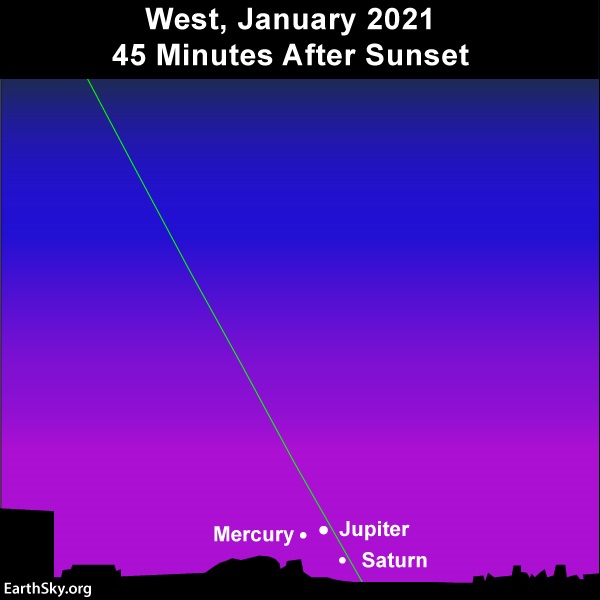For the first time since October 2015, you have a chance in the coming evenings to view a planetary trio, or three planets bunched together on the sky’s dome. At evening dusk – on January 8, 9, 10 and 11, 2021 – watch for the now-famous planets Jupiter and Saturn, fresh from their December 21 great conjunction and still close together. The third planet, Mercury, is just now coming into view. All three worlds pop out low in the west, close to the sunset point on the horizon. Jupiter will be the brightest of the three, followed by Mercury and then Saturn. Start watching them tonight and watch them move in relationship to each other!
On January 8 and 9, bright Jupiter will be at the top of the gathering. The sky chart at top is for January 9, 2021, when fleet-footed Mercury will pass to the south of Saturn.
The tightest grouping of these worlds will be on January 10.
Then Mercury will swing to the south of Jupiter on July 11, as shown on the chart below.
Depending on your sky conditions and use of optical aid (binoculars), you should be able to watch this planetary trio for several days to a week.
Are you an early bird? The moon is near Venus this weekend

By definition, a planetary trio consists of three planets fitting within a circle whose diameter is less than 5 degrees in width. For reference, three fingers held together at an arm length approximates 5 degrees. Given that a typical binocular field of view spans 5 degrees or more, binoculars come in super handy for viewing a planetary trio. If you spot Jupiter with the eye alone, but not Mercury or Saturn, aim binoculars at Jupiter to see the threesome taking stage in a single binocular field!
At their closest, the planets of this planetary trio will fit inside a circle with a diameter of 2 1/2 degrees on January 10 (at 19:00 UTC; translate UTC to your time).
To maximize your chances of catching these worlds, find an unobstructed horizon in the direction of sunset. All the planets of this planetary trio will follow the sun beneath the horizon by nightfall, so it’s imperative that you start your search no later than 45 minutes after sundown. Jupiter is about 2 1/2 times brighter than Mercury, and 10 times brighter than Saturn (which makes Mercury about 4 times brighter than Saturn).
Although all these worlds are bright – especially Jupiter – they’ll be contending with the afterglow of sunset. You might need your binoculars to catch one or two of these planets, especially Saturn.
Live in the United States or Canada? Find out when Mercury, Jupiter and Saturn set in your sky via the Old Farmer’s Almanac.
From virtually anywhere in the world, find out the setting times for Mercury, Jupiter and Saturn via TimeandDate.com.
Here’s what’s on tap for the evenings between January 9 and 11:
January 9, 2021 (21:00 UTC): Mercury passes 1 2/3 degrees south of Saturn
January 10, 2021 (19:00 UTC): Planetary trio fits inside 2 1/2-degree circle
January 11, 2021 (11:00 UTC): Mercury passes 1 1/2 degrees south of Jupiter
Day by day, Mercury will be climbing upward, away from the afterglow of sunset, while Jupiter and Saturn will be sinking toward the sun. Jupiter and Saturn will soon fade from the evening sky. Mercury, in the meanwhile, will soar to its greatest eastern (evening) elongation on January 24, 2021, so Mercury should be in good view for weeks to come!
This planetary trio on January 10, 2021, presents the first of two planetary trios in in the year 2021; and the first of four planetary trios in the 203rd decade or the period from January 1, 2021, to December 31, 2030:
January 10, 2021 (Mercury, Jupiter, Saturn)
February 13, 2021 (Mercury, Venus, Jupiter)
April 20, 2026 (Mercury, Mars, Saturn)
June 16, 2028 (Mercury, Venus, Mars)
Bottom line: For a sky watching challenge, try spotting the planetary trio of Mercury, Jupiter and Saturn around January 8, 9, 10 and 11, 2021. You’ll find a second planetary trio – Mercury, Venus and Jupiter – in the February 2021 morning sky.
Read more: Moon near Venus on the mornings of January 9, 10 and 11











